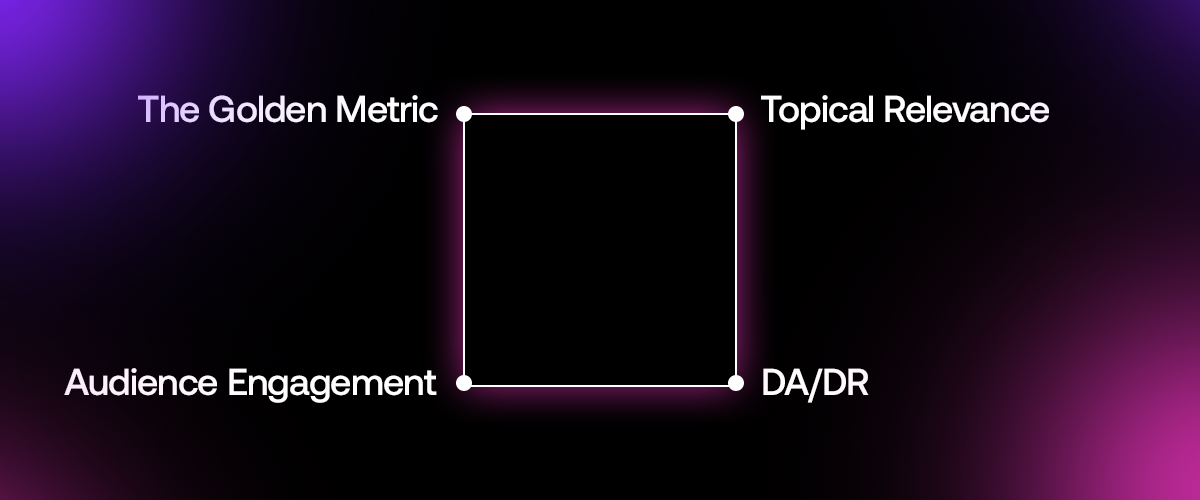You just spent $300 on a "High DA" guest post. You got the link, the post is live... and nothing happens. Your rankings don't move, you get no traffic, and you're left wondering what went wrong.
Here's the truth: you were tracking the wrong metrics.
In 2025, the guest posting industry is full of sellers who profit from "vanity metrics" like DA or DR. These numbers are easy to fake and tell you nothing about a site's real value.
This guide is a masterclass in how to stop buying vanity and start investing in value. We'll deconstruct the metrics that are just noise and show you the ones that actually lead to rankings and revenue.
Guest Post Metrics: The Cheat Sheet
Here's the professional framework for evaluating any guest post opportunity:
- The #1 Rule: Relevance & Traffic Over Authority. A link from a low-DR, high-traffic blog in your exact niche is 1,000 times more valuable than a high-DR link from a generic, irrelevant site.
- The "Vanity" Metric: DA & DR. Domain Authority and Domain Rating are third-party scores. Use them as an initial filter (e.g., "ignore sites under DR 20"), not as a final decision-maker.
- The "Golden" Metric: Verifiable Organic Traffic. A site with real, stable, monthly visitors is a site that Google provably trusts. This is the single most important signal of a quality placement.
- The Real ROI: The true success of a guest post is measured in referral traffic, keyword movement, and conversions, not just the link itself.
On This Page
- The DA/DR Trap: Why Vanity Metrics Will Kill Your ROI
- The 4 Vetting Metrics: What to Analyze Before You Buy
- The Performance Metrics: How to Track Your ROI After You Buy
- Vetting Guest Post Services FAQ
The DA/DR Trap: Why Vanity Metrics Will Kill Your ROI
For years, the SEO industry was obsessed with Domain Authority (DA) and Domain Rating (DR). Today, these metrics are traps for new buyers.
Here's why they are flawed:
- They Are Third-Party Metrics: Google does not use DA or DR. They are scores created by Moz and Ahrefs to estimate a site's authority. They are not a direct ranking factor.
- They Are Easily Faked: A site's DA or DR can be artificially inflated with thousands of cheap, spammy links. A high score does not mean a site is high-quality.
- They Lack All Context: A DR 60 site about car repair has zero topical authority for your SaaS product. Without relevance, the high DR is just a meaningless number.
Relying on DA/DR alone is like buying a car based on its shiny paint job without ever checking the engine.
The 4 Vetting Metrics: What to Analyze Before You Buy

Instead of just looking at DA, a professional uses a 4-point framework to vet every single opportunity.
1. The Golden Metric: Verifiable Organic Traffic
You can fake DA, but you can't fake a long history of real, stable traffic from Google.
- What it is: The number of people who visit a website each month from organic search results.
- How to Check: Use a tool like Ahrefs or Semrush. Plug in the website's URL and look at its organic traffic graph.
- What to Look For: A graph that is stable or growing. This is your proof that Google trusts this site and sees it as a valuable resource.
- The Red Flag: A site with a high DR but "0" organic traffic. This is a "zombie domain" that has metrics but no audience and no trust from Google.
2. Topical Relevance: The Context King
A link from a relevant site is a powerful signal. A link from an irrelevant site is, at best, a weak signal and, at worst, a spam signal.
- What it is: How closely the website's main topic aligns with your own.
- How to Check: Read the site's homepage, "About" page, and recent blog posts. Is it in your industry?
- The Pro-Tip: Go deeper. Don't just look for "business" blogs. If you sell marketing software, a link from a "sales leadership" blog is good, but a link from a "marketing automation" blog is a goldmine. Hyper-relevance wins.
3. Audience Engagement: The "Real People" Test
Does a real, living human actually read this blog? A real audience is a sign of a healthy, helpful site.
- What it is: Proof that the site's content is being consumed and discussed.
- How to Check:
- Blog Comments: Are there real, thoughtful comments on the articles?
- Social Shares: Are posts being shared on LinkedIn, X (Twitter), or Facebook?
- Author Bios: Does the site feature real authors with names, photos, and social media profiles?
- The Red Flag: A site with no comments, no social presence, and all articles published by "Admin." This is a ghost town.
4. DA/DR: The Final Filter
After you've confirmed a site has real traffic, topical relevance, and an engaged audience, then you can use DA or DR as a final filter.
- What it is: A general measure of the site's overall backlink strength.
- How to Use It: Use it to set a minimum benchmark. For example, "I will only consider sites that pass my 3-point check and have a DR of 25 or higher."
- The Key: Never choose a DR 60 site with no traffic over a DR 30 site with 10,000 monthly visitors.
How to Find Services That Pass the Vetting Test
This level of vetting takes time. It requires SEO tools and a trained eye. The safest way to buy guest posts is through a transparent marketplace where you can see a seller's full history and reviews.
On Legiit, you can find top-rated providers who specialize in securing placements on high-traffic, relevant sites. You can filter sellers based on their verified reviews, ensuring you partner with someone who understands real value.
The Performance Metrics: How to Track Your ROI After You Buy
You've vetted a site and your post is live. Your job isn't done. Now you must track your results to prove the ROI.
SEO Metrics (The Long-Term Value)
- Keyword Rankings: This is the big one. Did the page you linked to (your "money page") move up in the SERPs for its target keywords? Track this weekly.
- Backlink Acquisition: When Google indexes your guest post, that new, high-quality link will appear in your Ahrefs or Google Search Console backlink profile.
Business Metrics (The Immediate Value)
- Referral Traffic: Use Google Analytics to see how many people are clicking the link in your guest post and visiting your site. This is a direct, tangible return.
- Conversions: This is the most advanced metric. By using a UTM parameter on your link, you can track exactly how many of those referral visitors signed up for a free trial, downloaded your e-book, or purchased your product.
Vetting Guest Post Services FAQ
Is guest posting worth it in 2025?
Yes, but the strategy has changed. Low-quality guest posting on irrelevant "link farms" is worthless. Strategic guest posting on high-traffic, relevant, and authoritative blogs is one of the most powerful and sustainable ways to build authority and drive growth.
Is guest posting real or fake?
Legitimate guest posting, where you provide real value to another site's audience in exchange for a link, is a very real and effective marketing strategy. "Fake" guest posting refers to buying links from worthless, low-quality sites that exist only to sell links. This is why vetting is so critical.
Which platform is best for guest posting?
The best platform is one that offers transparency, variety, and real social proof. A marketplace like Legiit is ideal because you can compare hundreds of different sellers, see their full work history, and read verified reviews from past buyers before you make a decision.
What are the top key performance indicators (KPIs) for guest posting?
The top 5 KPIs, in order of importance, are:
- Keyword Ranking Improvement (SEO Value)
- Referral Traffic (Business Value)
- Conversions (e.g., leads, sign-ups) (Business Value)
- Audience Engagement (e.g., shares, comments on the post) (Brand Value)
- Backlink Acquired (SEO Value)
What are the four metrics of customer service?
While typically for support, this concept applies to vetting a service. When vetting a seller, look for:
- Response Time: How fast do they reply to your questions?
- Transparency: Are they open and honest about their process and the sites they use?
- Past Reviews: What is their customer satisfaction score from verified buyers?
- Problem Resolution: Do reviews mention how they handle issues if something goes wrong?
Stop Buying Vanity Metrics. Start Investing in Results.
The days of simply "buying DA" are over. To win in 2025, you must be a savvy investor. Use this guide to shift your focus from vanity metrics to the signals that truly matter: traffic, relevance, and audience.
Instead of navigating this complex vetting process alone, you can hire a professional on Legiit who specializes in securing high-quality placements. Browse services from top-rated sellers who already have relationships with the high-traffic blogs you want to be on.














 Download
Download